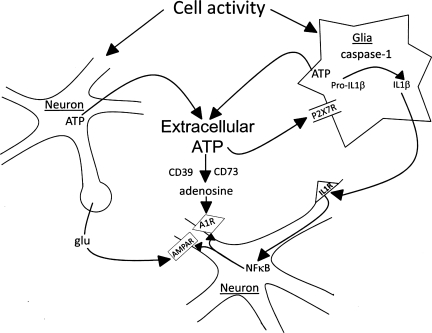Fig. 8.
Extracellular ATP involvement in sleep regulation. ATP is released into the extracellular space as a consequence of cell activity during neuro- or gliotransmission. Extracellular ATP then activates P2 receptors (R), e.g., P2X7, that in turn are involved in IL1 processing and release as well as release of other sleep regulatory substances such as tumor necrosis factor and brain-derived neurotrophic factor (not shown). IL1, in turn, activates nuclear factor-κB (NF-κB), leading to changes in receptor trafficking. This changes the cell's long-term sensitivity to neurotransmitters such as glutamate (glu) and to neuromodulators such as adenosine. Extracellular ATP is also catabolized to adenosine via the actions of ectonucleotidases such as CD39 and CD73; this action is faster than the ATP-P2-induced changes in transcription and translation. Both actions of ATP are likely involved in sleep regulation. AMPA, amino-3-hydroxy-5-methyl-4-isoxazole proprionic acid.

